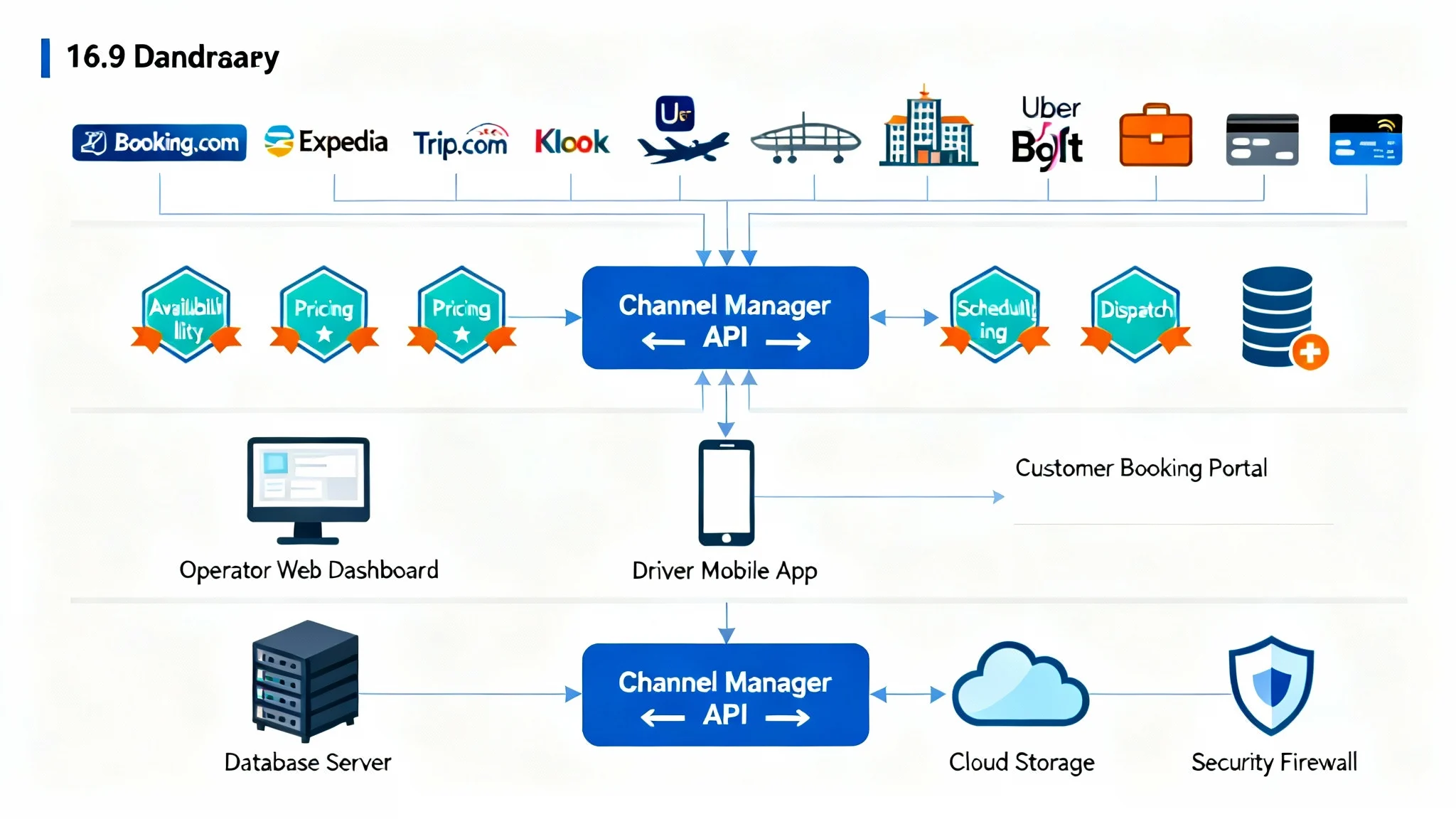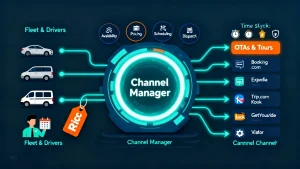Channel Manager for Taxis & Transfers: Connect to OTAs, Prevent Overbooking, Grow Revenue

The Future of Ground Transportation: Why Taxi and Transfer Operators Need a Channel Manager
Introduction
Travel has gone fully digital. Travelers expect instant booking, accurate pricing, and reliable confirmation for everything—hotels, flights, and ground transport included.
Hotels solved this long ago with Channel Managers—systems that sync availability and rates across multiple sales channels. The same approach is now transforming airport taxis, shuttles, and transfer fleets.
The key to making it work? Understanding the role OTAs (Online Travel Agencies) play in the ecosystem.
What Is a Channel Manager—and Why Do OTAs Matter?
In hospitality:
- A Channel Manager connects a hotel’s inventory and prices to OTAs like Booking.com or Expedia.
- It updates availability in real time to prevent double-booking.
- Staff update details once, and changes flow everywhere.
For taxis and transfers, swap rooms for vehicles, drivers, time slots, and routes—the logic is identical.
What Is an OTA?
An Online Travel Agency is a digital marketplace where travelers research, compare, and book services.

- For hotels: OTAs list rooms, properties, reviews, and prices.
- For ground transport: OTAs increasingly list airport transfers, shuttles, taxis, limousines, and private cars.
Examples:
-
Global OTAs: Booking.com, Expedia, Trip.com
-
Experiences/Tours: Viator, Klook, GetYourGuide
-
Regional marketplaces: Local leaders by geography
-
OTAs concentrate traveler demand in one place.
-
Without a Channel Manager, keeping pricing and inventory aligned across many OTAs is nearly impossible.
Applying a Channel Manager to Taxis and Transfers
Transfer bookings come from multiple sources:
- OTAs (pre-arranged airport pickups via Booking.com, Expedia, etc.)
- Ride-hailing (on-demand at the curb)
- Hotels (concierge desk or booking engines)
- Direct channels (your website or app)
- Corporate travel platforms
A Taxi/Transfer Channel Manager connects all these demand sources to your fleet’s real-time availability and pricing—keeping everything accurate and in sync.
Why OTAs Matter for Taxi and Transfer Companies
- High Visibility: Millions plan trips on OTAs daily—be present where they’re shopping.
- Upsell Momentum: Flights and hotels often bundle transfers, turning OTAs into direct sales channels.
- Market Expansion: Reach international travelers unfamiliar with local brands.
- Customer Trust: Many prefer booking through platforms they already use.
- Revenue Growth: More exposure leads to more bookings and better fleet utilization.
Where OTAs Fit in the Tech Stack
Think of a Channel Manager Hub:
- Left (Supply): Fleet, drivers, vehicles, shifts.
- Center (Hub): Channel Manager software pushing real-time updates.
- Right (Channels):
- OTAs: Booking.com, Expedia, Trip.com, Klook, Viator, GetYourGuide
- Ride-Hailing: Uber, Bolt, Lyft, Careem, FreeNow
- Airline and Airport Systems
- Hotel Booking Engines and Concierge Desks
- Corporate Travel Platforms
- Direct Website and App
OTAs are the first, most powerful distribution layer for travel planning.
Minimal App Ecosystem: What You Actually Need
You don’t need a dozen apps. Structure your ecosystem around 2–3 end-user apps plus one operator hub.
- Web Apps
- Operator Dashboard (B2B): Fleet managers, dispatchers, admins
- Manage vehicles, drivers, schedules, and pricing
- View bookings from OTAs, ride-hailing, and direct sources
- Apply rules (surge pricing, blackout periods)
- Reporting and analytics
- Acts as the Channel Manager Hub
- Booking Website (B2C): Tourists and business travelers
- Search routes and prices
- Book and pay online
- Real-time confirmation synced with OTAs
- Mobile Apps
- Traveler App (B2C)
- Book transfers, taxis, and shuttles
- Track driver ETA in real time
- Manage reservations and payments
- Driver App (B2D)
- Receive assignments
- Navigation and route guidance
- Update status (Arrived → Pickup → Completed)
- Sync shifts/availability with the Channel Manager
Core Applications
- Operator Web Dashboard (fleet management)
- Driver Mobile App (assignments and tracking)
- Customer Booking App/Website (booking and payments)
- Optional: Hotel Concierge Portal and Corporate Portal
Minimum Viable Setup
- 1 Operator Admin Panel (Channel Manager)
- 1 Driver App
- 1 Customer-facing website/app (start with web; add mobile later)
Optional Additions
- Hotel Concierge Portal (for direct guest bookings)
- Corporate Booking Portal (accounts, invoicing, multi-rider support)
- API Layer (for OTA, airline, and partner integrations)
The Future of Transfers
Without OTAs, many taxi companies are invisible to international travelers. A Channel Manager automates listings across multiple OTAs and keeps inventory aligned—making transfers as discoverable and bookable as hotels and flights.
FAQs: OTAs and Channel Managers
- What does OTA stand for?
- Online Travel Agency (e.g., Booking.com, Expedia, GetYourGuide)
- Why connect to OTAs?
- Travelers book transfers where they book flights and hotels. If you’re not listed, a competitor is.
- Do OTAs charge commission?
- Yes—but you gain reach and volume you likely can’t get alone.
- Can one Channel Manager connect to multiple OTAs?
- That’s the point—update once, distribute everywhere.
- Is relying on OTAs risky?
- Diversify. Use OTAs plus ride-hailing, hotels, corporate, and direct channels. A Channel Manager makes multi-channel easy.
Technical and Implementation
- Timeline: 10–15 weeks for MVP; 3–6 months for major OTA certifications.
- Replace our booking system?
- Not required. Most Channel Managers integrate via APIs.
- What if an integration fails?
- Look for providers with fallbacks, 24/7 monitoring, and 99.5%+ SLAs.
- Start small and expand?
- Yes—begin with 2–3 OTAs and scale.
Operations and Control
- Do we lose pricing control?
- No—your rules apply everywhere, instantly.
- Too many bookings?
- Capacity rules prevent overbooking.
- Block time slots or routes?
- Yes—use blackout periods and custom availability rules.
- OTA customer service issues?
- Unified customer data and communication tools; some offer white-label support.
Data and Analytics
- Channel performance tracking?
- Yes—revenue, conversion, and performance by channel.
- Data ownership?
- You own direct-channel data. OTA shares vary by policy.
- Can we export data?
- Reputable providers support exports and migrations—confirm in contracts.
Security and Compliance
- Is data secure?
- Require PCI DSS, GDPR, SOC 2; encryption in transit and at rest.
- Vendor risk?
- Choose established providers; ensure data portability and consider source code escrow.
Business Impact
- Will this cannibalize direct bookings?
- Typically no—OTAs add new customers while direct remains stable.
- How fast are results?
- Listings live in 2–4 weeks; volume in 2–3 months; ROI in 6–12 months.
- Trial before commitment?
- Many offer pilots or limited-channel proofs of concept.
- Launch support?
- Look for onboarding, training, 24/7 tech support, and early-life account management.
Costs and ROI (Planning Benchmarks)
- Channel Manager (SaaS): $99–$499/month per operator or $3–$8/vehicle/month
- Integrations (per major partner): $5,000–$25,000 one-time
- OTA Commissions: 10–25% per booking
- Ride-Hailing Platform Fees: 5–25%
- Direct Payments Processing: ~2.9% + $0.30
- Messaging (SMS/notifications): $0.01–$0.05/message
- Cloud/Infrastructure: $200–$2,000/month
- Support and Maintenance: 15–25% of build cost annually
- Implementation Timeline: 10–15 weeks for MVP
Note: Actuals vary by region, vendor, and scope.
Conclusion
OTAs reshaped hotel bookings. Taxi and transfer operators that integrate with OTAs via a Channel Manager will:
- Gain global visibility
- Prevent overbooking
- Attract more passengers
- Grow revenue
For ground transportation, OTA connectivity plus Channel Management isn’t just an upgrade—it’s the next standard.